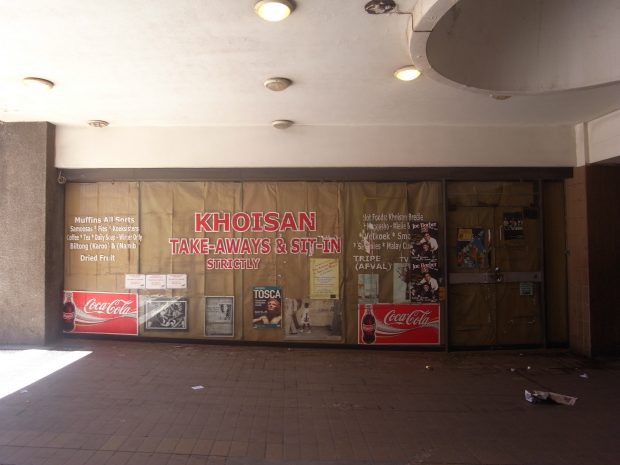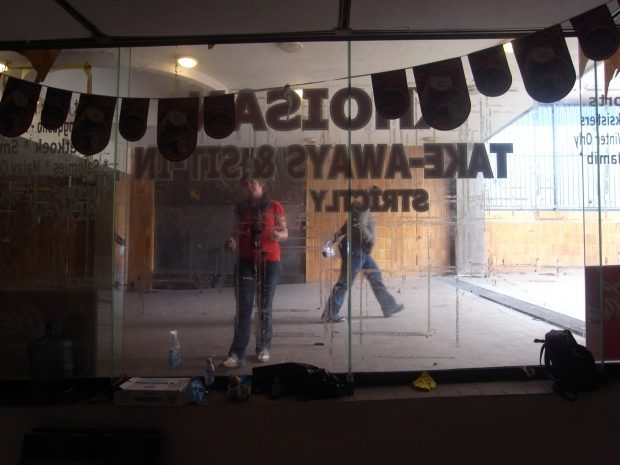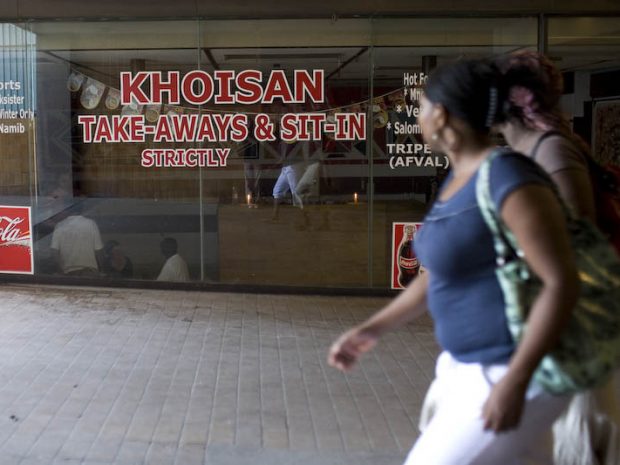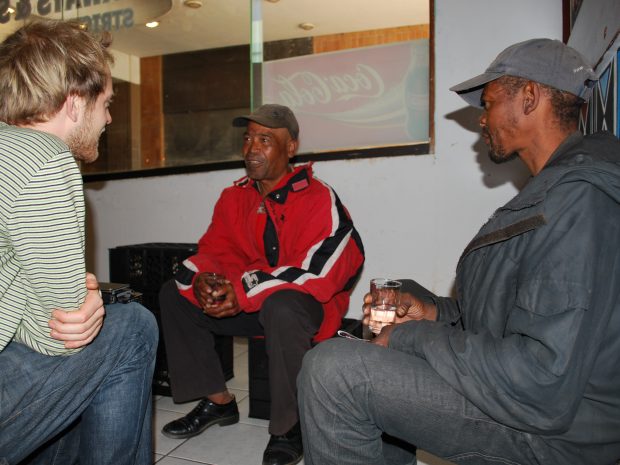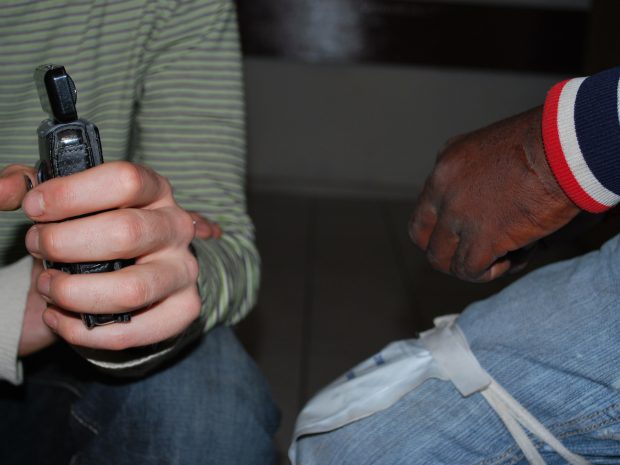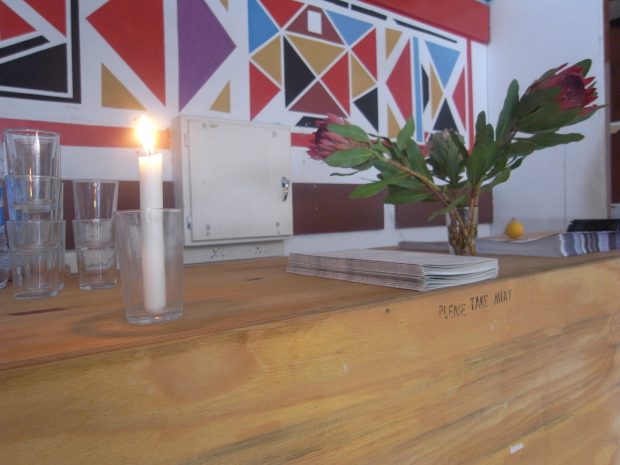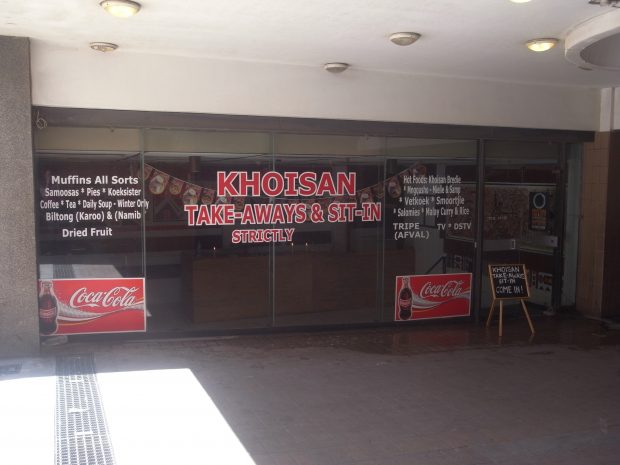Between the 21st of January and the 13th of March 2010 we were invited to conduct a three-week research residency in Cape Town. ‘The naming and claiming of space’ began by investigating the way in which locations in Cape Town have been repeatedly renamed, revealing historic and contemporary demographics of power, culture and segregation, before looking in more detail at the lack of conventionally mapped references to Cape Town’s indigenous heritage. The residency culminated in a series of site-specific interventions and events that took place during the Infecting the City festival.
Activity #1: ‘take-aways’ and ‘sit-ins’
The papered-up remains of the ‘KHOISAN TAKE-AWAYS & SIT-IN’ were (bizarrely) the only direct reference that we could find relating to the Khoi or the San in the city centre. The building was owned by the city, who, having evicted the previous tenants, would soon be refurbishing the area as part of the regeneration programme being implemented for the world cup. A steady flow of pedestrians walks past the shop, using the underpass that leads to the central station.
We were granted permission to re-open the space for a period of four days, an intervention that also created a base from which we would operate for the duration of the festival. Visitors were offered a variety of ‘take-aways’ and ‘sit-ins’ that facilitated and contextualised our activities.
Day 1: Cleaning and preparing the space
Tuesday the 16th of February
The first day was spent cleaning the shop. As we peeled off the layers of tape, paper, and dirt from the original ‘Khoisan take-away…’ lettering, we wondered if this activity presented a metaphor for what we were trying to achieve in Cape Town, and how it simultaneously highlighted the potential problematic of this role (do we have the right to do this?). We also realised how unusual it is in Cape Town for a ‘white’ person to be seen cleaning and were inundated with requests for work, eventually employing two people to help us with the work.
Very few people seemed to remember the take-away before it had been closed to the public. It was nice how pedestrians walking past the shop would read out-loud the name of the take-away. Time after time we would here the words “Khoisan take-away”, as if passers-by were allowing the words to roll off the tongue, and be left hanging (unanswered) in the underpass.
Day 2+3: ‘Sit-ins’
Wednesday the 17th and Thursday the 18th of February
Calling on the ancestors.
A sit-in usually involved an informal discussion that explored personal ancestry, the ancestry and cultural heritage of Cape Town, and the plurality of identity. Visitors also had the opportunity to browse documentation that we had collected during our three-week period of research and development.
It surprised us how little people seemed to know about their personal ancestral roots. Older guests talked of how this had been suppressed, either through trauma or forms of apartheid education/indoctrination, while younger guests mentioned how seldom their parents wanted to talk about their cultural heritage or family tree. Those that had experienced trauma in their lives seemed to welcome an opportunity to tell their story, and were keen to have this story recorded. Most of our visitors told us that they would like to know more about their ancestry, and there was a general interest and openness towards the Khoe and San histories/cultures. One guest left us with the words, “Thank-you, you are giving me my culture back”.
Although we are happy with how the take-away intervention unfolded, it was also conducted under immense time pressure. We were given permission to inhabit the take-away two days into the festival! There was potential for more events, more involvement from the Khoe and San community, more structured encounters with our visitors, and more integration with the festival programme.
We would have liked to open the take-away for a full week, to let the idea and functionality of the space grow, and give relationships the chance to establish themselves. It would have been to create a browsable archive of stories (or non-stories), let people draw their family trees onto the walls, hold Khoe/San language school lessons, and host lunchtime concerts.
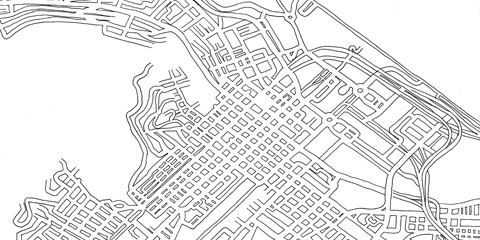
Day 2+3: ‘Take-aways’
Wednesday the 17th and Thursday the 18th of February
An alternative map of Cape Town was available to take-away. The positions of four new memorial sites and the Khoisan take-away were marked on a street map of Cape Town, from which all of the existing street and place names had been removed. The mountains were included as orienteering devices.
The following instructions were offered to frame the user’s journey through the city:
Search for Cape Town‘s ancestry
Look at how your identity is reflected in the city
Find the features of one person in those of the next
Navigate the city as a natural landscape
Small pockets of information were then inserted into the map, including the different names that have been used for Cape Town and a description of the individuals to whom each memorial was dedicated. On the back of the map you could find a catalogue of indigenous herbs, and a summary of the project.
Visitors could pick up a copy of the map from the Cape Town tourist information centre, the Talk Show TV Café, the Buchu fountain, and the Khoisan take-away.
Differences of opinion
There were differences of opinion as to what function the map should have. Bradley van Sitters wanted a map whose primary aim would be to inform and educate. We wanted a map that would be used more as a catalyst for reflection and debate, alongside a limited amount of information that would contextualise this activity. In the end we landed somewhere in the middle, creating more of a flier for the other projects than a standalone project.
The map was an area that we would have liked to develop further, taking a closer look at traditional Khoe and San naming methodologies (as much as this is still possible) and exploring how these might be used to re-brand a modern-day Cape Town, and create a form of contemporary Khoe/San cartography.
From what we have learnt it seems that indigenous inhabitants of the Western Cape often drew on an observation of the natural environment to generate names; an outward focus on space as opposed to an inward focus on oneself. To what extent could this be transferred to an urban environment, using street names that try to describe or understand the city’s architectural and geographical qualities, as opposed to politicised names that reflect demographics of power or ownership? How would this change in emphasis allow us to see, understand, discover or imagine the city in a different way? How would it affect our sense of (dis)place, identity and orientation?
